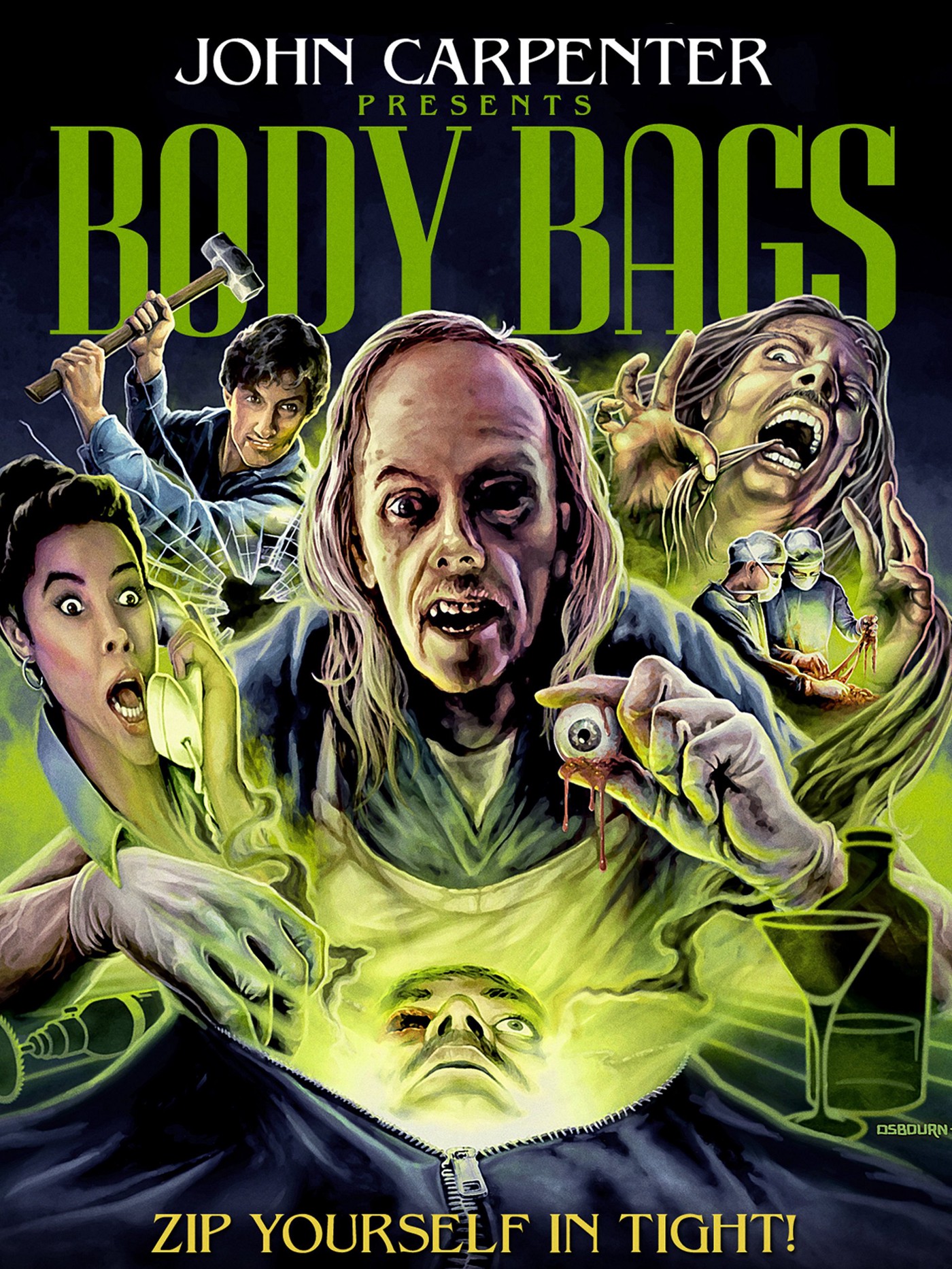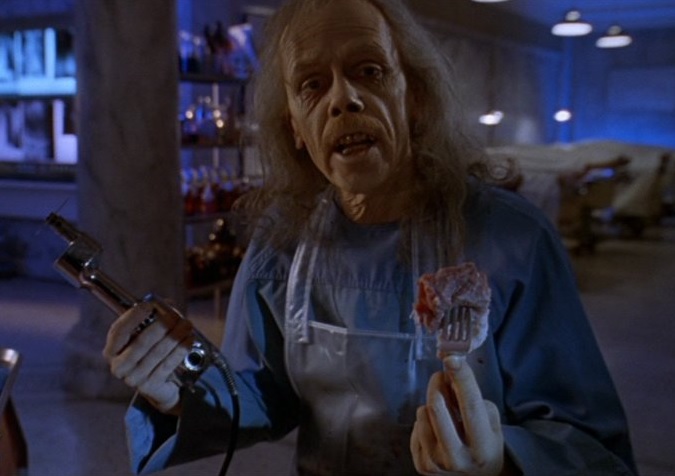Body Bags, a 1993 American horror-comedy anthology television film made for television with three unconnected storylines with bookend segments starring John Carpenter and Tobe Hooper as insane morgue attendants, is the subject of this video. When horror anthologies resurfaced on television in the late 1980s and early 1990s, Body Bags was a must-see concept with an ominous expiration date.
It is recognized for its celebrity appearances. It was only natural for Showtime to want in on the fun, and who better to assist them than John Carpenter and Tobe Hooper? Of course, a decade ago, when the duo was at the height of their respective powers, the response may have been more powerful.
The film is a magnificent showcase of mutilations and manglings of various kinds. With Carpenter and Hooper at the helm, it is also well-made. Despite this, neither of them has a clear memory of their prior glory. In the decade since Artisan released a long-out-of-print DVD, Carpenter and Hooper’s films have sunk into obscurity.
Body Bags, for the most part, exemplifies this stagnation because it is an uninspired attempt to replicate the grandeur of other anthologies and, as a result, feels like a collection of discarded pieces from other programs; yet, it is generally enriched, both in concept and execution.
Since Creepshow, Body Bags is probably the most entertaining and absurd horror anthology. When it comes down to Carpenter and Hooper’s basic bones, none of the film’s segments approach anything approximating uncharted territory: the first unfolds like an urban legend, the second is a goofy little morality play, and the third blends medical terror with serial-killer psychopathology. These scenes are mainly reliant on a typical stinging dark comedy tone. In this overcrowded morgue, KNB’s gruesome effects work is plastered across every slab.
Zip Yourself in Tight – Body Bags (1993)

A creepy-looking coroner tells three separate horror stories about his present job with cadavers in “body bags.” John Carpenter serves as our host, and it’s amusing to see a man responsible for terrorizing so many people act so ridiculous here. It reminds me a little of Stephen King in Creepshow, albeit he’s not quite as outrageous.
The Coroner is presented seated at a modest, neatly arranged dining table, as a power surgical saw whines in the background. He gets up from his dinner, a rare blood steak, and starts his rounds. Bodies were to be found everywhere — on gurneys, on autopsy tables, and in vaults. Obviously, the Coroner is searching for an excellent narrative to tell us. He gets what he’s seeking – the body bags – by avoiding bodies labeled “death by natural causes.”
The Coroner’s eyes brighten. “These are fun,” he replies, smiling. “You see, they stuff ’em in the bags when there’s a murder, suicide, or a horrible accident.” It prevents spills. Yes, each one has a tale to tell…” While two morgue employees take a coffee break, the Coroner relates the first of three stories. However, when directing the first two episodes, Carpenter is back on familiar terrain.
The first tale, The Gas Station, is typical Carpenter fare. “The Gas Station” is by far the greatest of the series. It kind of conveys a message about women’s safety. In “The Gas Station,” newcomer Anne played by Alex Datcher, works the night shift at a lonely filling station surrounded by a sky so dark you could hack it with a machete.
After showing her around the premises, which are pretty much limited to one tiny glass booth, Bill played by Robert Carradine, leaves her to deal with a slew of assorted weirdos, including a memorably lecherous Wes Craven, but not before warning her about a violent killer who has escaped from the local loony bin. The attending worker, Bill, played by Robert Carradine, exits and informs Anne that a serial murderer has escaped from a mental institution and warns her not to leave the station’s booth, which must be kept secured at all times.
After Bill goes, Anne is alone, as she interacts with numerous late-night customers looking to buy gas for a quick fill-up. At the same time, Anne stays confined in her booth, unclear of who the fugitive madman is. When Anne fears that the escaped killer is prowling around the gas station, she attempts to call the police, only to discover that the phone line is dead.
By breaking into the locked cubicle and following Anne around the vacant garage. The conclusion describes how the killer ended up in a body bag. With the heroine, Alex Datcher dashing around, many twists, and a grisly dispatch of the maniac at the conclusion, he produces a good level of tension. Another of Carpenter’s superb melodic compositions is used to accompany the program.
“Hair” is about Richard Roberts, played by Stacy Keach, a balding middle-aged guy who is immensely nervous about his receding hairline. His fixation on becoming bald and his ways of maintaining his dignity and self-esteem have resulted in a rift between him and his long-suffering lover Megan, played by Sheena Easton.
As his fears begin to sever his relationship with his fiancée, he chooses to undergo “miraculous” therapy to give himself new hair. The transplant appears to be a success at first, with Richard developing a full head of hair overnight. The next day, Richard wakes up and removes the bandage wrapped around his head during the medical surgery.
He is pleased to see that he now has a stallion-style complete set of hair. However, after a few days, Richard begins to feel ill and weary as his hair grows longer and longer, even in areas where hair would not ordinarily grow.
The episode is a little creepy, especially when Stacy Keach’s hair crawls across the floor of the hairdressing salon; when he wakes up to find hair growing all over his body, including out of his throat; or when he cuts the hair over the bathroom sink, and it squeals, only to be revealed under a microscope to resemble a long miniature snake.
After attempting to clip several hairs off, he discovers that his hair ‘bleeds,’ and upon examination with a magnifying glass, discovers that they are alive. Richard returns to Dr. Lock for an explanation. Still, he finds himself imprisoned as Dr. Lock explains that he and his entire staff are aliens from another planet who seek out narcissist humans and plant hair seeds in their bodies for growth and consumption as part of their plan to spread their alien essence throughout the earth.
Richard was their most recent victim. The creepiness of the show is considerably undermined by a poor twist ending that reveals the hair is all part of an extraterrestrial invasion plot, which has been clearly hinted at by the clinic’s name – Roswell Hair Laboratories. “The Gas Station” has a good setup. The revelation is fantastic, seeming like a story you’d tell over a campfire with friends one night, which is probably true of practically all of Carpenter’s early works.
The third episode, “Eye,” tells the story of Brent Matthews, played by Mark Hamill, a professional baseball player. He loses his eye in a terrible automobile accident. His life and career are turned upside down when he is involved in a horrific vehicle accident in which his left eye is gouged out.
Unwilling to accept that his career is finished, he seizes the opportunity when a doctor informs him of an experimental medical operation that can replace his eye with one from a recently dead person and restore his sight. Brent is pleased to see through his new vision after the procedure. He enables himself to undergo an experimental process to replace his destroyed eye since he does not want to abandon his profession.
The strange colors of his eyes set the tone of the episode. With his new sight, Brent begins to experience awful images of dead bodies, as well as himself murdering women, after a while. However, soon after, Brent starts to see things that others cannot see through his new eye, putting him and his wife, Cathy (Twiggy), in peril as Brent begins to have dreams about killing women and having sex with them.
Brent approaches the doctor, who informs him that the donor of his new eye was a recently executed serial killer and necrophile who murdered countless young women prior to having sex with their mutilated corpses. Brent becomes persuaded that the deceased killer’s soul is slowly taking over his body via his eye, allowing him to kill women.
He discovers that his new eye was donated by John Randle, a lunatic. The latter murdered women and abused their bodies, and was just executed. The horrible images result from Randle’s spirit controlling Brent through his eye and allowing him to resume his murdering rampage.
Brent, realizing it is just a matter of time until the killer reappears, stabs his donated eye with garden scissors, cutting his bond with the killer, but then he bleeds to death. While “Eye” is entertaining to watch, its last episode shares far too many parallels with “Hair,” which it immediately follows, even down to the ludicrous performance of a cameo actor as the transplanting doctor, this time with fellow horror maestro Roger Corman picking up the knife.
Having said that, this is a unique and strange performance by Mark Hamill, who looks and sounds like you’ve never seen him before. The heavy-handed Biblical quotations throughout the novel foreshadow the story’s ending. Tobe Hooper, one of Carpenter’s contemporaries best known for directing The Texas Chain Saw Massacre (1974) and Poltergeist (1986), has taken over as director (1982).
Mark Hamill portrays a minor league baseball player involved in a car accident and loses his right eye in “Eye,” while Lawson plays his wife. In 1977, Hamill was involved in a vehicle accident and had seven hours of reconstructive surgery on his face, which dramatically altered his look in the film “The Empire Strikes Back.”
Lesley Lawson’s first husband Michael Whitney had a real-life acting career. Whitney was a minor league baseball player with the Hornell Dodgers and the Great Falls Electrics before beginning his acting career.
“The Gas Station” is also not a straight comedy. This chapter is exciting and shocking as it builds to the last act’s horrific conclusion. Carpenter’s commitment to detail: both as a filmmaker and as a composer is evident in “Hair.” Still, this second narrative closely parallels Stephen King’s Cat’s Eye part “Quitters, Inc.” The tongue-in-cheek performances make for a far more comical than terrifying edition.
Mechanics of the horror genre and is more whimsical here than in virtually all of his ’90s work. Whereas Hooper’s contribution, “Eye,” fits in tonally with the other stories, it has a gloomier feeling of dread than the other Carpenter-directed portions. On the other hand, the notion is as frightening as it gets, and the CGI follicles are excellent for the occasion.
If the Body Bags series had been picked up and “Eye” had been put someplace less close to John Carpenter’s “Hair,” the parallels would not have been as evident; yet, viewed as a whole, “Eye” is a pleasant and hilarious concluding piece in this terrifying anthology. Overall, Body Bags is a simple and cliché yet amusing experience. Even though he was a little too hammy at times, the coroner character brought this horror-comedy together beautifully.
The essence of a late-night horror film you’d see on a weird station, only to be perplexed by all the odd cameos. The latter two parts have a common thematic thread, making The Gas Station the odd man out. One wishes the film could have gone the other way. If all three portions had been drastically different, Body Bags would have profited from diversity.
In an odd, serendipitous sense, John Carpenter is a director whose work appears appropriate for an anthology. Body Bags was created as a pilot film for what was clearly an effort to launch an anthology horror television series. Carpenter had a cult following in the 1980s thanks to classics like Escape from New York and The Thing. The notion of a Body Bags TV series failed to gain traction.
Body Bags is totally a Carpenter affair, bearing his cheeky humor, spooky atmosphere, and skillful wrangling of naturally fascinating character performers, with one piece directed by Tobe Hooper, who makes a cameo appearance in the picture. In some ways, the series’ promise is damaging to the film itself, as the parts play with the simmering undertones of a squandered chance.
The Coroner has just finished telling the viewers his three stories when he hears a noise outside the morgue and crawls back inside a body bag, revealing that he has been a living corpse the entire time, as two other morgue workers begin to work on this ‘John Doe’ corpse that was just delivered to them.
Two men do an autopsy on him. When they take a pause, the Coroner winks at the camera, his innards flowing out of him. Returning to the County Morgue, the victim is now the Coroner. “By the way, come by again another night,” he says, a wicked smirk on his face. “I’m sure there are a couple more good stories down here.”
Why should you watch Body Bags?

Body Bags is a fun trip into strange and subversive horror, all wrapped up in a half-hour drama that feels more like extended B-plots than a three-act narrative. However, omnibus films are inherently inconsistent and, at times, unmanageable affairs. The power of the combined performances and the directors’ attention to the dynamics of visual narrative may be credited to the fact that Body Bags primarily works, despite the apparent absence of fresh material.
Body Bags, starring Robert Carradine, Mark Hamill, David Warner, Stacy Keach, Tom Arnold, and Deborah Harry, adds a grinning awareness to its characters. Body Bags, maybe the anthology’s most valuable asset, includes an outstanding ensemble of genre greats and horror icons over all three episodes and even the wraparound.
Director John Carpenter’s superb eye attends to every detail in every picture, from the bloodiest to the most peaceful. The inherent silliness of each scene propels the film firmly into the domain of comic horror while avoiding the pitfalls of the cartoonish camp.
If horror anthologies – or cinematic anthologies of any kind – have a flaw, it’s that the stories are meant to lead to an abrupt conclusion; because the narratives are less intricate than a full-length feature, it’s easy to anticipate the payoff coming long before it arrives. Body Bags’ fundamental flaw is that, like Tales from the Crypt’s Crypt keeper, John Carpenter is not cut out to perform the whole ghoulishly cackling, awful puns thing as a narrator.
Carpenter has never performed in front of a camera before, and his performance here is campy and very ridiculous. Furthermore, the tongue-in-cheek attitude to horror is diametrically opposed to Carpenter’s films, which all take themselves seriously and aren’t exactly known for their comedic elements. Body Bags is suitable as a whole, but it lacks cohesion.
On the other hand, the film may have been a good compilation of warning tales about body alteration if it had a better start. That it doesn’t accomplish either makes it difficult to shake the idea that this is nothing more than a half-hearted effort aimed more at capitalizing on a trend than anything else.
Thus, Body Bags at least sounds like a classic, synth-laden Carpenter. Its variety of entertaining performances and cameos is also a boon. Body Bags, if nothing else, convincingly replicates the carnival-style atmosphere of Tales from the Crypt and Tales from the Darkside, even if it ultimately feels like a generic knock-off of both.
Overall, Body Bags is still a lot of fun, and it’s packed with early 1990s horror with many famous names. Sadly, we didn’t get a show or anything from this series, but it seems like this will last forever. There’s a lot of suspense, a decent dosage of black comedy, and many outstanding performances.
What began as a notion for an anthology series evolved into a relatively excellent anthology horror picture with the help of filmmaker John Carpenter. It’s not the finest anthology film ever created. It’s not even in the top 10 anthology horror films of all time.
Still, it offers a pleasant horror journey with three stories of various quality and frequently abrupt shifts in tone. The Body Bags on Blu-ray is a lot of fun to see, with Carpenter’s portrayal as the presenter of the wraparound parts “The Coroner” being the genuine highlight of this anthology.
